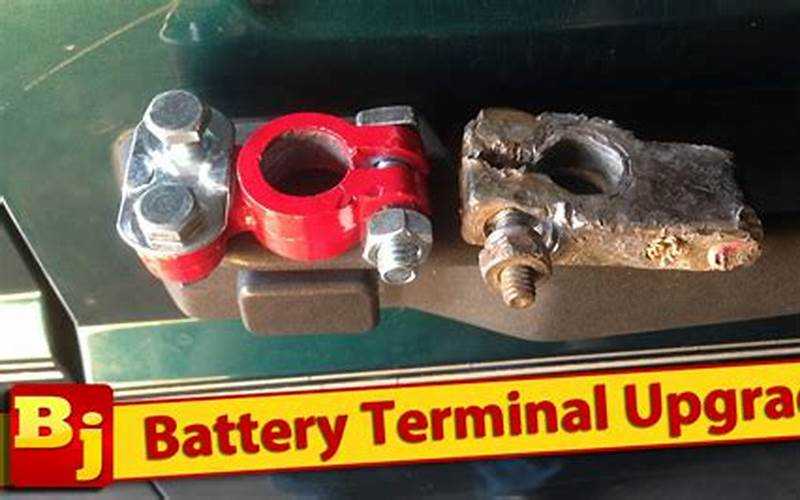
 Source: bing.com
Source: bing.com
Introduction
Hello Vehicle Owner,
Welcome to our comprehensive guide on battery terminal fix. In this article, we will delve into the importance of maintaining a proper connection between your vehicle’s battery and its terminals. We will explore the common issues that arise due to loose or corroded terminals and provide you with step-by-step instructions on how to fix them.
Having a well-functioning battery is crucial for the smooth operation of your vehicle. Neglecting battery terminal issues can lead to a host of problems, including difficulty starting your car, unreliable electrical systems, and even permanent damage to your battery. By following the methods outlined in this article, you can ensure a secure and reliable connection, extend your battery’s lifespan, and avoid unnecessary expenses.
So, let’s dive into the world of battery terminal fixes and equip ourselves with the knowledge to keep our vehicles running smoothly!
Strengths of Battery Terminal Fix
1. ? Improved Electrical Connection: Properly fixing battery terminals ensures a solid electrical connection, allowing for efficient power transfer and reliable performance.
2. ?️ Easy DIY Maintenance: The methods for fixing battery terminals are simple and can be done by any vehicle owner with basic tools, saving time and money on professional assistance.
3. ? Enhanced Battery Life: By addressing terminal issues promptly, you can extend the lifespan of your battery, avoiding premature replacements and reducing long-term costs.
4. ? Reliable Vehicle Start: Loose or corroded terminals can cause starting issues. Fixing the terminals ensures your vehicle starts reliably, saving you from being stranded in inconvenient situations.
5. ? Prevents Electrical Damage: Loose connections can lead to electrical arcing, which can damage delicate electronic components in your vehicle. Fixing the terminals prevents potential damage and costly repairs.
6. ?️ Resistant to Corrosion: Properly fixed terminals are less prone to corrosion, reducing the risk of further issues and extending the life of your battery.
7. ? Versatile Applications: The techniques and tips provided in this article can be applied to various types of batteries, including those used in cars, motorcycles, boats, and recreational vehicles.
Weaknesses of Battery Terminal Fix
1. 
2. ? Tools and Equipment: While the tools required for fixing battery terminals are commonly available, some vehicle owners may need to purchase them if they don’t already have them on hand.
3. ? Safety Precautions: Working with batteries involves handling corrosive substances and electrical components. It’s essential to take proper safety precautions to avoid injury or damage.
4. ? Temporary Fixes: In some cases, fixing the terminals may only provide a temporary solution. If the terminals or cables are severely damaged, replacement may be necessary.
5. ? Technical Knowledge: While the methods provided in this article are beginner-friendly, some vehicle owners may struggle with the technical aspects of fixing battery terminals.
6. ?️ Environmental Impact: Proper disposal of old batteries and corrosive materials is important to minimize the environmental impact. Ensure you follow proper disposal guidelines.
7. ? Professional Assistance: In certain situations, such as complex electrical issues or extensive damage, seeking professional assistance may be necessary, adding to the overall cost.
Table: Battery Terminal Fix Methods and Tools
| Method | Tools Required |
|---|---|
| Cleaning Corroded Terminals | Wire brush, baking soda, water, safety goggles, gloves |
| Tightening Loose Terminals | Wrench or pliers |
| Replacing Damaged Terminals | Terminal cleaner, replacement terminals, wrench or pliers |
Frequently Asked Questions (FAQs)
1. Why are battery terminals important?
Battery terminals serve as the connection points between your vehicle’s battery and the electrical system. They ensure a proper flow of electricity, allowing various components to function efficiently.
2. How do I know if my battery terminals need fixing?
Common signs of terminal issues include difficulty starting the vehicle, flickering lights, or a loose connection. Additionally, visible corrosion or a buildup of white powdery substance on the terminals indicates a problem.
3. Can I use household cleaning products to clean battery terminals?
No, it’s best to use a mixture of baking soda and water to clean battery terminals. Household cleaning products may contain chemicals that can damage the terminals.
4. Can I fix battery terminals without disconnecting the battery?
While it’s possible to clean terminals without disconnecting the battery, it is highly recommended to disconnect the negative terminal before performing any maintenance to avoid electrical shock or damage.
5. How often should I check and fix my battery terminals?
Regularly inspect your battery terminals during routine vehicle maintenance. It’s recommended to check them every few months or if you experience any electrical issues.
6. Can I use a wire brush to clean the terminals?
Yes, a wire brush is an effective tool for cleaning corrosion off battery terminals. Ensure you use a brush specifically designed for this purpose and not a regular metal brush.
7. Can I use petroleum jelly on the terminals?
While petroleum jelly can help prevent future corrosion, it’s important to apply it sparingly. Excessive jelly can attract dust and dirt, potentially leading to further issues.
Conclusion
Now that you have a comprehensive understanding of battery terminal fixes, it’s time to take action and ensure your vehicle’s electrical system is in top shape. Regular maintenance and prompt fixing of terminal issues will not only extend your battery’s lifespan but also provide a reliable and hassle-free driving experience.
Remember, a well-maintained battery is the heart of your vehicle’s electrical system, and investing time and effort in its care will pay off in the long run. So, grab your tools, follow the steps outlined in this article, and watch your battery-related worries fade away!
Disclaimer: The information provided in this article is for educational purposes only. Always exercise caution and follow proper safety procedures when working with batteries and electrical components. If you are unsure or uncomfortable with performing the tasks mentioned, seek professional assistance.
 MyVans Your Vehicle Solution
MyVans Your Vehicle Solution